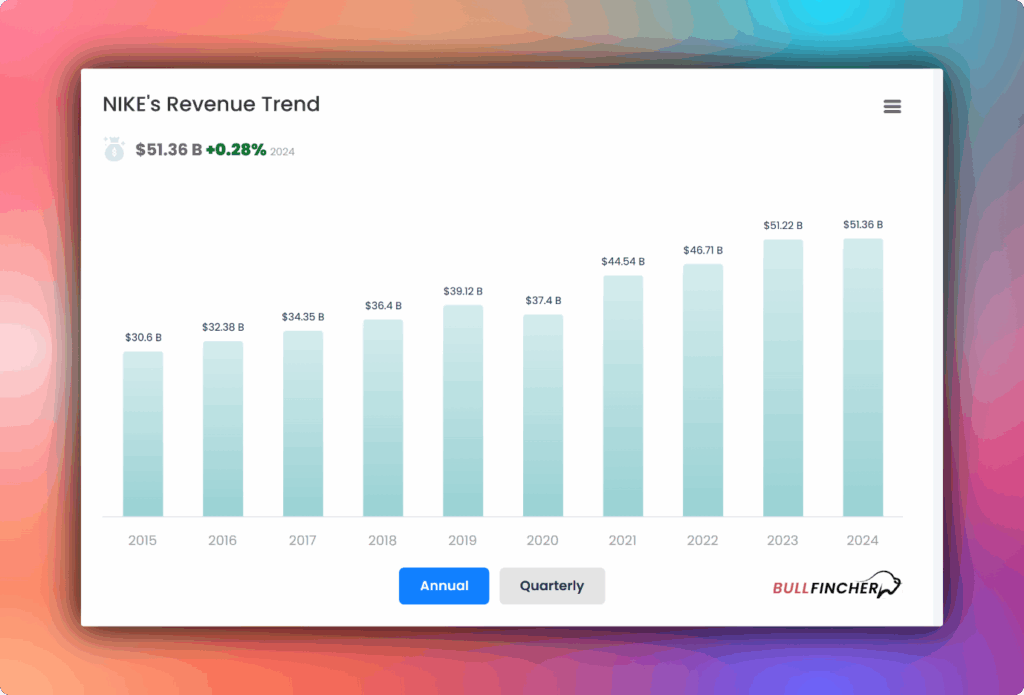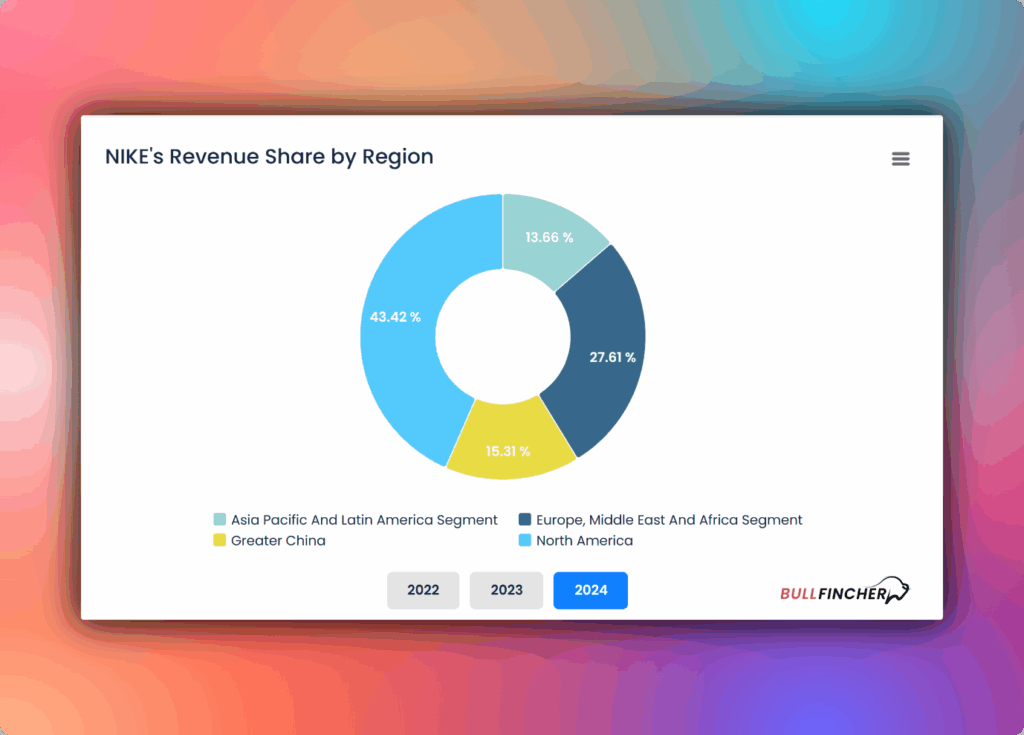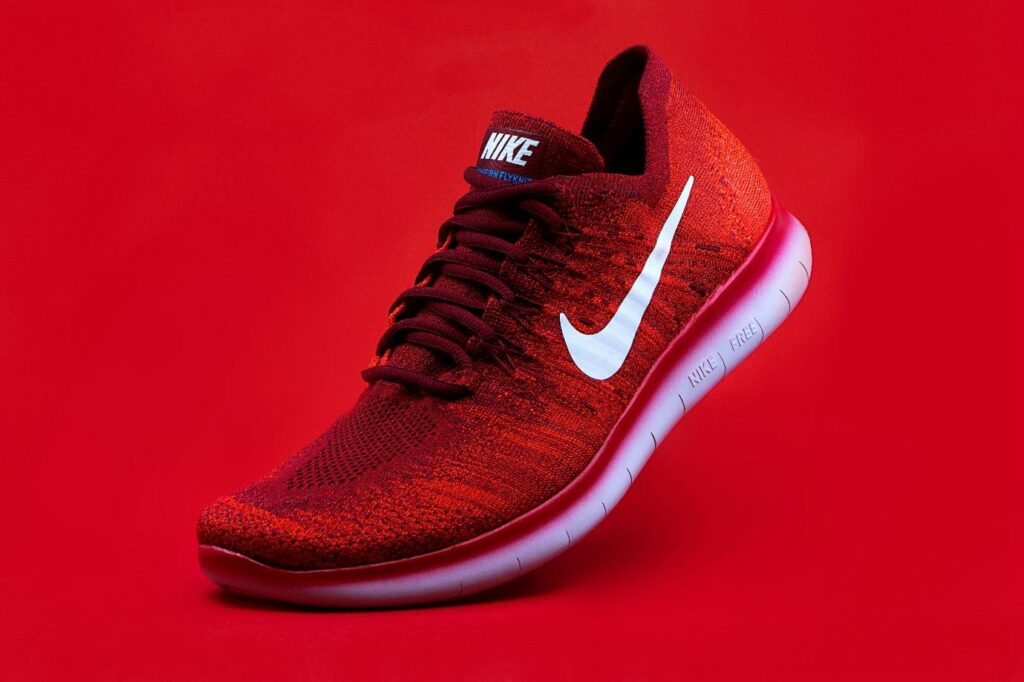Company: Nike, Inc.
CEO: Elliott Hill
Year founded: 1964
Headquarter: Beaverton, Oregon, USA
Number of Employees : 79,400
Type: Public
Ticker Symbol: NKE
Market Cap (May 2025): $85.93 Billion
Annual Revenue (FY2024): $91.9 Billion
Profit | Net Income (FY2024): $9.5 Billion
Products & Services: Athletic Apparel | Sports & Casual Shoes | Sportswear & Lifestyle Clothing | Sports Equipment | Accessories | Customization Services | Web & Mobile App | Sport Research Tech (NSRL) | Membership Program
Competitors: Adidas | Puma | VF Corp | Under Armour | Lululemon | ANTA Sports | New Balance | Skechers | ASICS | Ralph Lauren | Reebok | Converse | Lacoste | Gucci
Fun Fact:
Nike’s iconic “swoosh” logo was designed by Carolyn Davidson for only $35.
Nike is the world’s largest supplier of athletic shoes and apparel. The company sells its products under the Nike Golf, Nike Pro, Nike+, Nike Blazers, Air Force 1, Nike Dunk, Air Max, Nike Skateboarding, Foamposite, and Nike CR7 labels. It owns the Air Jordan and Converse brands. Nike’s marketing strategy differentiates the company from competitors and drives sustainable growth and success. In 2024, Nike generated $51.36 billion in annual revenue, with $5.7 billion in profit. [1]
Image Source: Bullfincher.io
To understand Nike’s secret to success, here is a comprehensive analysis of its marketing strategy:
Nike’s Target Market Overview
Nike’s target market cuts across demographics, psychographic groups, and regions globally. For example, in 2024, Nike generated 43.42% of its revenue ($21.4 billion) from North America, 27.61% ($13.6 billion) from Europe, 15.31% ($7.5 billion) from China, and 13.66% ($6.7 billion) from Latin America and Asia-Pacific. The company primarily focuses on active, fashion-conscious individuals aged 15-45. It targets teens and young adults by tailoring products and marketing strategies to address their interests.
Nike understands that its young target audience responds effectively to emotion-based advertising. The company applies this understanding to its marketing strategy by ensuring its ads don’t explicitly focus on a product. For example, Nike creates a brand image that reflects its customers’ aspirations rather than the products’ innovative features. This strategy helps the company connect with its ideal target market, increasing customer loyalty, engagement, and sales. [2]
Nike caters to all genders with innovative footwear, apparel, accessories, and sports goods. Its marketing efforts focus on athletes and weekend warriors. In FY2024, Nike’s top revenue generator was the footwear segment, with $33 billion. Its apparel division accumulated $13.8 billion. The company targets eco-conscious consumers by incorporating sustainability into its products and marketing messages. [3]
Nike customizes its marketing strategies to meet local preferences, including fashion trends and sports popularity. Its products appeal to athletes, sports fans, and anyone with an active lifestyle. The company introduced its iconic 2017 Nike Vaporfly “super shoe,” the first commercial running shoe with a carbon-fiber plate in the midsole. Kenya’s Kelvin Kiptum won the 2024 Chicago Marathon in 2:00:35 and broke the men’s record by 34 seconds while wearing Nike’s newest trainers, the Alphafly 3. [4]
Image Source: Bullfincher.io
Nike’s Positioning Strategy
Nike’s brand positioning statement: “For athletes needing high-quality, fashionable athletic wear, Nike provides customers with top-performing sports apparel and shoes made of the highest quality materials.” It defines Nike’s marketing strategies, product development, and value creation. For example, Nike’s brand positioning statement outlines how its products serve all athletes. It also demonstrates Nike’s belief that anyone can be an athlete to appeal to different age groups, genders, and demographics.
Another component of Nike’s positioning strategy is its brand identity and personality. The company leverages its mission and positioning statements to connect with the audience based on inclusivity and empowerment values. It creates high-quality, high-performance products for all athletes, from runners to cyclists, weight lifters, and golfers. Its marketing campaigns highlight its brand promise. For example, Nike created a video ad to show its commitment to inspiring every athlete. [5]
Nike refines its positioning and marketing strategy to align with consumer needs and preferences. Its latest plan is to shift more resources from performance marketing to brand building. In 2024, Nike extended agreements with leagues, the NBA, the NFL, the WNBA, the Brazil Football Confederation, and FC Barcelona to reconnect with consumers. It plans to reduce promotional discounts to strengthen its position as a premium, full-price brand. “We’re starting to shift dollars from performance to brand marketing,” said CEO Elliott Hill, “Ultimately, with sports as our North Star, we will reenergize our culture and identity.” [6]
Nike is the world’s largest sportswear brand, with more than double the annual revenue of its closest competitor, Adidas. The company protects its leadership position by creating world-class products and investing in marketing campaigns. In FY2024, Nike spent over $4 billion on advertising and promotion. Adidas’ marketing and point-of-sale expenses were €2.5 billion ($2.7 billion) in FY2023. This $1.3-billion gap gives Nike an edge over its top rival, strengthening its market position. [7]
Nike’s Value Proposition
Nike’s value proposition is defined by its mission: “bring inspiration and innovation to every athlete worldwide.” It achieves this goal by offering high-quality, innovative, stylish athletic products. For example, Nike’s shoes, apparel, equipment, and accessories combine cutting-edge technologies and designs to deliver the best experience on and off the field, increasing customers’ value for money. These products use advanced materials to enhance performance, comfort, and durability. The company tailors its offerings and marketing efforts to resonate with customers’ needs, boosting brand loyalty. [8]
Nike enhances its value proposition by making its products accessible and customizable via its online platforms, partner retailers, and wholesalers. The company offers many performance and lifestyle items with different styles, sizes, and customization options. It caters to anyone seeking excellence in sports and life. For example, athletes can leverage Nike’s customization to create specialized gear and apparel to fulfill unique sports needs. This offering helps customers increase their value for money. [9]
Nike’s value proposition focuses on inspiring consumers to live active, eco-conscious, and healthy lifestyles. It achieves this mission by integrating sustainability into its production and enhancing access to sports and physical activity. The company creates sustainable products to support consumers’ eco-conscious lifestyles and protect the planet. In 2023, Nike launched its Link Axis shoes made from recycled materials. It is designed to minimize waste. [10]
Nike’s Marketing Mix (4P) Analysis
Nike’s marketing mix (4Ps) focuses on products, pricing, place (sales and distribution points), and promotion to drive sustainable growth and profitability. Each element contributes to Nike’s overall marketing strategy. Here is an in-depth analysis of Nike’s 4Ps:
1. Nike’s Products
Nike offers many products, including footwear, apparel, sporting equipment, and accessories. The company sells these items under Nike, Nike Golf, Nike Pro, Nike+, Nike Blazers, Air Force 1, Nike Dunk, Air Max, Foamposite, Nike Skateboarding, and Nike CR7. It also owns the Air Jordan and Converse brands. Each Nike brand offers innovative products. The company expands its offerings to address the needs of its target markets and groups. As of Jan 2025, Nike was #8 on Fortune’s “America’s Most Innovative Companies” list. [11]
Nike enhances its product development strategy by investing in R&D and cutting-edge tech. Its R&D initiatives create sportswear and leisurewear versions with the latest technologies and materials. The company leverages advanced technologies to transform product design and streamline the customer experience with personalized offerings. For example, Nike used AI-optimized Athlete Imagined Revolution (AIR) technology in 2024 to accelerate product innovation. This AI initiative was supported by Nike’s tech-powered Sports Research Lab. The company also leveraged GenAI on its AIR project to create prototype shoes for top athletes like Sha’Carri Richardson and Kylian Mbappé in 2024. These prototypes were based on the athletes’ preferences. [12]
2. Nike’s Place
Nike sells its products through partner retailers, company-owned eCommerce platforms, and Niketown stores. Consumers can purchase Nike’s shoes, apparel, sports equipment, and accessories in local and regional stores, as well as leading chains such as Walmart and Target. Its point-of-sale strategy leverages a multichannel approach to enhance accessibility, convenience, and the shopping experience. In 2023, the company had over 1,000 Nike stores worldwide. Its arch-rival, Adidas, operated around 2,000 retail outlets in 2024. [13]
Nike’s commitment to a direct-to-consumer (DTC) approach drives its global expansion. Its distribution network spans 190 countries, providing a direct connection with consumers. DTC allows Nike to leverage its stores, online platforms, and partner retail outlets to personalize customer experiences. The company uses its website, mobile apps, and social media channels to launch and promote its latest products globally. For example, Nike released the Nike Air Max Dn8 on nike.com, and Nike retailed in adult and youth sizes with new colorways. [14]
Supply chain efficiency and digital sales channels contribute to Nike’s marketing and point-of-sale strategy. Nike’s over-commitment to e-commerce and challenges in the Chinese market strained performance in 2024, leading to a 31.71% stock price decline. It recorded a 10% year-on-year drop in digital revenue. As of Dec 2022, Nike’s inventory surged to $9.7 billion due to supply chain disruptions and sales stagnation. The company addressed this issue by offering discounts. Although the strategy reduced inventory, it gutted profit margins. Nike’s decision to cut ties with leading wholesale retailers in 2021 strained its sales channels, worsening the situation further. [15]
3. Nike’s Promotion
Nike combines different promotions, including advertising, personal selling, direct marketing, discounts, and public relations. These marketing efforts attract new customers, retain existing clients, and boost brand loyalty. The company also uses promotions to dispose of excess or old products in its inventory. For example, Nike offered a 10% birthday discount in Mar 2025. Consumers signed up on its website to qualify and redeem this promotional gift by logging into their Nike accounts. The company also provides discounts, such as 10% off for military and their spouses, first responders, medical professionals, students, and teachers. [16]
4. Nike’s Price
Nike has a rich history of innovation and success, driven by several strategic approaches, including a comprehensive global pricing strategy, market segmentation, effective marketing, and robust distribution channels. The company is synonymous with athletic excellence. Its global pricing approach combines premium and value-based pricing strategies. For example, Nike’s value-based pricing strategy presents products as high-quality, exclusive items based on its excellent brand image and innovative features. The company justifies its premium pricing using limited edition releases and value-added services, like customization options and personalized shopping experiences. [17]
Nike’s Promotional Strategy
Nike’s promotional strategy combines several marketing approaches to showcase its products’ innovative features. The company runs ads to show how its technologies and designs help athletes achieve peak performance. Nike also uses geographic segmentation to adapt its products and promotional campaigns to local cultural and weather trends. For example, Nike doesn’t offer its warmest winter shoes and apparel in mild to hot countries.
Nike promotes its products in different geographic regions by starring regional and national athletes in its ad campaigns. For example, Nike launched the “Nothing Beats a Londoner” campaign with London athletes and real-life citizens to target the hyper-local London youth market. [18]
Another component of Nike’s promotional strategy is emotional branding. It uses emotion-based messages to target “aspirers” and “succeeders” in its consumer segments. This strategy inspires people to achieve their best and motivates them to be fit and stay on trend. Nike’s promotional strategies include celebrity endorsements and sports sponsorships. For example, the company sponsors Cristiano Ronaldo, Rafael Nadal, LeBron James, Naomi Osaka, and Rory McIlroy. These high-profile professional athletes use and promote Nike’s products and technologies. The company also provides uniforms and equipment to leading sports teams. In 2024, FC Barcelona and Nike signed a new multi-year agreement to renew their strategic alliance and reinforce their collaboration from the 2024/2025 season. [19]
Nike refines its promotional strategy for continuous improvement. This approach allows the company to cater to the consumers’ evolving needs and fend off emerging competitors. In 2024, Nike announced plans to reduce its promotional activity, slash performance marketing spend, and invest more in a full-price model. The company launched its “Winning isn’t for Everyone” campaign before the Summer Olympics to empower athletes. It extended this initiative with “Winning isn’t Comfortable” to target professional runners. This version won Ad Age’s best campaign of the year in 2024. [20]
Image by: Domino Studio
Nike’s Customer Acquisition & Retention
Nike uses traditional and data-driven strategies to attract and retain customers. Its approach prioritizes product innovation, customer experience, active lifestyle, and sports-focused communities. The company leverages social media to personalize marketing messages for different audiences and drive customer acquisition and retention efforts. For example, Nike maintains several Instagram channels like @NikeFootball, @NikeLA, and @NikeWellCollective. It tailors content for each channel to address specific interests. This approach ensures Nike attracts consumers across the board, from athletes to sports fans and fitness enthusiasts.
Another component of Nike’s customer acquisition and retention strategy is inclusivity. Its ads feature everyday people with unique life challenges and embody the spirit of “Just Do It.” For example, Nike’s iconic 1988 advertisement showcased a 80-year-old Walt Stack running across the Golden Gate Bridge. It reinforced the company’s commitment to inclusivity and brand statement: “If you have a body, you can be an athlete.” to reinforce its. [21]
Nike applies inclusivity principles and the “Just Do It” philosophy in its product lines. It designs footwear and apparel for disabled and injured people, ensuring equal access to sports and physical activity for everyone. For example, in Jan 2025, the company unveiled its new Nike x Hyperice recovery shoes to help people with weary tootsies recover from soreness and strain. This footwear doesn’t require heating pads and compression socks. Nike translates its commitment to diversity and inclusion into real-world action by investing in community programs, sports camps, and initiatives for underserved youth. [22]
Nike leverages its mobile app as a central hub to drive customer engagement and loyalty. It retains customers by enhancing access to its products. Customers can browse or purchase products, track workouts, and access personalized recommendations using Nike’s mobile app. In 2021, Nike temporarily cut ties with retailers like Macy’s and DSW to drive direct sales through its DTC model. The company tripled its mobile and digital business from 10% to 30% within four years. It renewed partnerships with wholesalers in 2023 to boost sales. [23]
Nike’s Marketing Goals (KPIs)
Nike’s marketing goals include market share growth. The company uses key performance indicators (KPIs) to assess its progress toward this objective. As of Nov 2023, Nike had a 38.23% market share in the US sportswear industry. Nike achieved global success thanks to its innovative marketing campaigns and product strategy. [24]
Nike aims to outperform competitors to grow its market share and customer base. Its yearly revenues exceed its rival’s earnings. As of Apr 2025, Nike had more global market share than VF Corp, Ralph Lauren, and Adidas combined. Adidas came second with a 12.71% market share, followed by VF at 5.10% and Ralph Lauren at 3.59%. Nike is one of the world’s most profitable companies. [25]
Nike’s STP informs its marketing goals and objectives. The company strives to maximize shareholder value and return on investment (ROI) by growing its market cap (a crucial KPI of success and influence in the consumer goods industry). Several factors drive this marketing goal, including stock price fluctuations, revenue and earnings, product innovation, and global expansion. In Dec 2024, Nike’s market cap was about $115 billion. This figure reflects Nike’s strong market position and appeal. Although Nike’s market cap had dropped to $85.93 billion as of May 2025, the company is still a dominant force in the sportswear and lifestyle apparel sectors. [26]
Nike implements marketing campaigns to increase brand awareness. It holds a compelling lead among the US sneaker audience and a high ownership rate globally. According to a Mar 2024 Statista survey, Nike was America’s most popular sneaker brand, with 65% and a 97% brand awareness score. 49% of US sneaker owners were loyal to the Nike brand and noticed Nike in the media, ads, or social media. The company had a 96% brand awareness score among IGen and Gen Z, 96% among Millennials and Gen Y, 96% among Gen X, and 99% among Baby Boomers as of Mar 2024. These stats indicate the effectiveness of Nike’s marketing strategy. [27]
Nike implements several marketing campaigns in Europe and the UK to grab market share in Adidas’s domestic region. It achieves this marketing goal by sponsoring high-profile EU and UK athletes and clubs. These efforts are paying off. According to a Statista survey, around 94% of online sports and outdoor goods shoppers in the UK and Germany recognized the Nike brand. Over 60% of the respondents liked the brand. [28]
References & more information
- Davies, K. (2025, Jan 14). Nike revenue 2005-2024. Statista
- io Staff (2024, Aug 7). Nike Target Market Segmentation: Customer Analysis & Marketing Goals. Start.io
- Davies, K. (2025, Jan 14). Nike’s global revenue in 2024 by product segment. Statista
- Clark, D. (2024, Jul 30). Inside the race to make the world’s fastest running shoes. The Financial Times
- Hodgson, S. (2024, Sep 11). How the Nike brand positioning strategy conquered all. Fabrik Brands
- Adams, P. (2024, Dec 20). Nike shifts more performance dollars to brand building as part of the reset. Marketing Dive
- Davies, K. (2025, Jan 14). Nike’s marketing expenses worldwide from 2014 to 2024. Statista
- Nike, Inc. What Is Nike’s Mission? Nike.com
- Vizologi (2024, Jan 4). Nike’s Winning Value Proposition Unveiled. Vizologi.com
- Monagas, D. (2023, Oct 5). Nike introduces a new sustainable shoe design. World Bio Market Insights
- Fortune Staff (2025, Jan 10). Ranking: America’s Most Innovative Companies. Fortune
- Mathews, A. (2024, Jul 3). How Nike uses AI to Transform Product Design, Customer Experience, and Operational Efficiency. AIM Research
- Statista Research Department (2025, Mar 21). Global sales of the top performance apparel, accessories, and footwear companies, 2024. Statista
- Nike, Inc. (2025, Mar 14). Nike Air Max Day 2025: Introducing the Air Max DN8. Nike.com
- GT Staff (2024, Jul 24). Why did Nike struggle while Adidas soared in 2024? The Global Treasurer
- So, A. (2025, Mar 7). Nike Promo Codes and Deals: Save up to 40% in May 2025. Wired
- Accelingo Staff (2024, Jan 16). Decoding Nike’s Global Strategy: A Guide to Market Dominance. Accelingo.com
- WARC Staff (2022, Jan 22). Nike: Nothing beats a Londoner. WARC.com
- FC Barcelona (2024, Dec 21). FC Barcelona and Nike, a renewed strategic alliance. Barcelona.com
- Adams, P. (2024, Jul 22). Nike kicks off marketing comeback with gritty Olympics ads. Marketing Dive
- Blavity Staff (2025, Jan 16). How Nike Turns Customers Into Lifelong Fans: 3 Marketing Strategies You Can Use Today. Blavity Inc.
- Reichert, C. (2025, Jan 9). Nike’s Prototype Shoes Squeezed and Heated Our Weary Feet at CES 2025. CNET
- Fonrouge, G. (2024, APR 12). Nike CEO says: it is focused on its website and stores went too far as it embraced wholesale retailers again. CNBC
- Gan, J. (2023, Dec 22). Analysis of Nike’s Brand Marketing Strategy. Research Gate
- CSI Market (2025, Apr 30). NKE’s Market share relative to its competitors as of Q1 2025. CSIMarket.com
- Payne, A. (2024, Dec 6). As an Iconic Athletic Brand, what is Nike’s Market Cap in 2024? Yahoo Finance
- SRD (2024, Sep 20). Nike brand profile in the US. Statista
- Kasia, D. (2025, Jan 14). Nike’s Global Sales. Statista
- Featured Image by Thomas Serer
- Shoe Image by Domino Studio
- Nike Overview by io
Tell us what you think? Did you find this article interesting? Share your thoughts and experiences in the comments section below.















Add comment